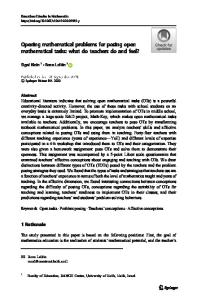Considering mathematical creative self-efficacy with problem posing as a measure of mathematical creativity
- PDF / 1,313,303 Bytes
- 29 Pages / 439.37 x 666.142 pts Page_size
- 29 Downloads / 356 Views
Considering mathematical creative self-efficacy with problem posing as a measure of mathematical creativity Ali Bicer 1
2
3
4
& Yujin Lee & Celal Perihan & Mary M. Capraro & Robert M. Capraro
4
Accepted: 2 October 2020/ # Springer Nature B.V. 2020
Abstract
The purpose of this study was to reveal both the effects of problem-posing interventions on the mathematical creative ability of students and how students’ creative self-efficacy in mathematics was related to their mathematical creative ability. Elementary school students (n = 205) were randomly assigned to one of two groups: problem-posing or control. Results showed the mathematical creativity for the problem-posing group increased (p < 0.05) more than for students in the control group (d = 0.77). Results from the Confirmatory Factor Analysis showed that mathematical creativity was a higher order factor that included mathematical creative ability and mathematical creative self-efficacy as first-order factors. Among the implications for this is that integrating problem-posing activities into elementary school mathematics instruction can foster mathematical creativity. Keywords Mathematical creativity . Mathematical creative self-efficacy . Problem posing . Elementary students . Mathematical creative ability
1 Introduction When discussing creativity in mathematics classrooms, researchers are less concerned with the creativity of a few eminent persons (big-C creativity; Levenson, 2013). They instead usually consider creativity in mathematics classrooms in terms of mini-c, that is, creative and meaningful insights experienced by students as they learn new concepts (Kaufman &
* Ali Bicer [email protected]
1
University of Wyoming, McWhinnie Hall 318, E Willett Dr, Laramie, WY 82072, USA
2
University of North Dakota, Grand Forks, ND, USA
3
Idaho State University, Pacatello, ID, USA
4
Texas A&M University, College Station, TX, USA
Bicer A. et al.
Beghetto, 2009). This type of creativity is the focus of the present study, which concentrates on the personally meaningful interpretations of experiences, actions, and events students have in mathematics classrooms (Levenson, 2013; Runco, 1996). Positive effects of some instructional interventions (e.g., problem-posing, open-ended problems, multiple-solution tasks) have been shown to foster students’ mathematical creativity (Bicer, 2020; Leikin, 2014; Leikin & Elgrably, 2019; Silver, 1997). Among these, problem posing has been suggested as one of the most promising instructional practices (see Albert & Kim, 2013; Leikin & Elgrably, 2019; Sriraman, 2005; Yuan & Sriraman, 2011) for developing students’ mathematical creativity. Importantly, the act of problem posing has been shown to be one of the best tools for making the three indicators (Silver, 1994) of mathematics creativity (i.e., fluency, flexibility, and originality) observable. Although researchers have identified problem posing as a strategy for fostering mathematical creativity (Crespo & Sinclair, 2008; English, 2003; Yuan & Sriraman, 2011), most stu
Data Loading...











